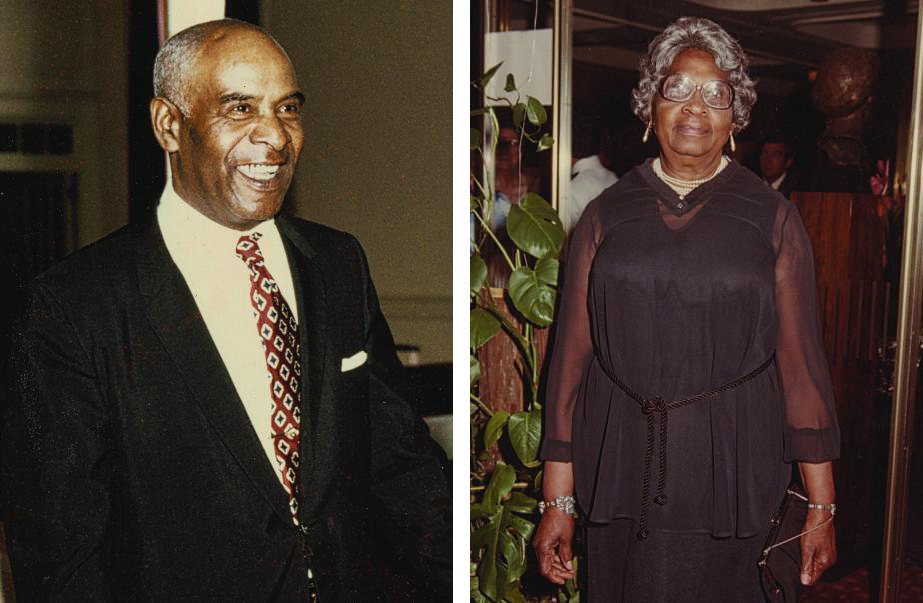Collect Day #29 HAZEL COLBERT SINCLAIR and CLAYTON SINCLAIR SR
O God who welcomes friend and stranger to your table and abhors any need for a “Green Book,” we remember today Hazel and Clayton Sinclair whose love for one another created a home and a place of safe welcome for those who found no room other inns; may we, like them, open our hearts to those who have been hurt by discrimination and exclusion; through Jesus Christ our welcoming Lord. Amen.

DAY #29, April 8, 2019
KITTERY POINT, MAINE
HAZEL COLBERT SINCLAIR (1901-1995)
CLAYTON SINCLAIR SR (1906-1978)
Valerie Cunningham
Hazel Sinclair kept a Green Book in her purse, ready to use whenever she and Clayton planned to travel beyond the Seacoast. They knew where African Americans were not welcomed locally, but had to prepare for travel elsewhere. In September, after closing the season at their summer guesthouse, the Sinclairs would have their own vacation visiting friends and family along the Atlantic coast, or touring popular landmarks across the country.
They met in 1936 while working as “the help” for what locals call “summer people.” At the end of the season, owners and servants would return to their respective residences in New York City.
Born in Baltimore, Hazel first came to Maine in 1929 as a lady’s maid for a New York woman; later, the lady persuaded her to be the cook. Clayton, from South Carolina, was the chauffeur for another New York family. Near the end of their summer courtship, Hazel and Clay decided to marry and to remain in the Seacoast instead of returning to New York. They had made friends in this vibrant African American community and were comfortable at the Black church. Clay found work at the Portsmouth Naval Shipyard and Hazel built a reputation as a cook and caterer for private families, often with Clay in his starched white jacket proudly assisting as server.
Hazel protested when Clay showed her what she described as “that old shack” in the woods of Kittery Point. But old Skipper Moore advised Clay it was valuable land, even if he could not fix up the house. So Clay convinced Hazel that he would make it work. With help from his friends, not only did he keep his promise, Hazel joked that he never stopped making improvements. Except when everything paused for World War II; Clayton served in the U.S. Navy, and Hazel went to work at the shipyard.
At the same time, increasing numbers of New York friends, and people referred by those friends, sought to stay with the Sinclairs for a few days to a week. By 1946, Hazel realized they could make their home into a summer guesthouse for traveling African Americans. They called it Rock Rest and it was known for its location near the ocean, with safe, clean accommodations, warm hospitality, and fine dining twice daily. There would have been no advantage to list Rock Rest in the Negro Motorist Guide Book because its seven rooms were booked in advance with meals only available to guests.
Clay’s well-kept grounds and colorful gardens added sophisticated charm to this relaxed rural setting. Off-season, the Sinclairs had the same warm greeting for local friends stopping by as they extended to paid guests; often sharing fabulous holiday dinners. Clay had his year-round job at the shipyard, and also ws involved in the community, including serving on the Kittery planning bard and as senior deacon at People’s Baptist Church. Hazel, also active at church, helped care for homebound elders, and worked with the League of Women Voters in York. On quiet evenings at home, she was crocheting place mats for the dinning room table and soft gifts for babies.
The Sinclairs helped establish New Hampshire’s first NAACP branch in 1958 and fought for social justice in housing and public accommodations. By the 1970’s when Clayton had passed and Hazel had retired, Black travelers had many lodging options and civil rights laws to support them. The Portsmouth Black Heritage Trail was honored to be entrusted by the Sinclair family to preserve the memory of Rock Rest.
Rock Rest memorabilia can be seen Dimond Library’s Special Collections at the University of New Hampshire in Durham, and at the Smithsonian’s National Museum of African American History and Culture in Washington, DC.
